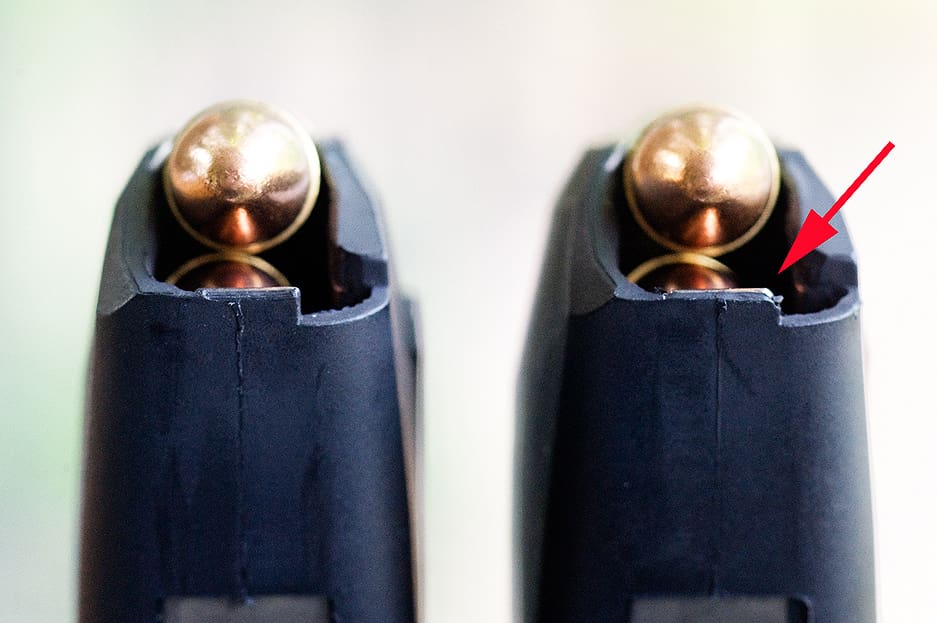I like to futz with my guns as much as the next guy. I’m one of those geeks who actually enjoys cleaning them. A little lower down on the fun scale: fixing something that’s wrong. I know a fair amount about how my guns work, but I’m no expert, never mind a diagnostician. But there are ways to make finding and fixing some problems easier.
I bought a Kel Tec Sub-2000 because it’s fun and cheap to shoot. And I chose one that takes GLOCK magazines because you can get them everywhere. Oh, and those 33-round mags are a pretty great idea in a carbine.
Fast forward to the days after the Lochner shooting. The grabbers had latched onto those 33-round mags (or assault clips, as they called them) which, as you know, are only good for one thing. Since I only owned one 33-rounder, I decided it’d be good idea to hedge my bets and buy a few more.
But there was trouble in my Teutonic paradise. Two of the four new mags had high failure to feed problems. At least one per 33 rounds. I switched ammo (from Winchester white box to Mag Tech) which helped, but it didn’t eliminate the problems.
It turns out there was some real inconsistency in the way the mags were made. I don’t know the technical name for metal feed lips (see photo, below), but some were squared off cleanly and some weren’t. And the plastic of the magazine bodies around the lips wasn’t molded consistently either.
Worse, I was at the range at the time, juggling five mags trying to identify which were the good ones and which were the problem children. I’d stuff some in a pocket trying to keep them separated, but a couple of times I got them mixed up.
Long story short, it would have made things a helluva lot easier if there’s been some way to ID each magazine. The simple solution? Save yourself some headaches, drop by your local art or craft store and pick up a white paint marker. Then number your mags.
Magazine parts don’t last forever. Springs and followers will eventually wear out. When a mag starts giving you FTF issues, it’s awfully convenient to be able to glance at the number on the bottom and make a mental note of the offender. Then you can address the problem when you get home.






I take this a step further actually… When a magazine is new, I use one of those Dymo LetraTag labelers that I bought from Wal-Mart and print off labels for each one. I label them with my name (helps at competitions!), “Mag #X”, and the date. When the magazines are serviced, i.e. new springs/followers, I simply print off a new label with a new date. I was skeptical about how long that those thin paper labels would hold up, but I have put hundreds upon hundreds of rounds through each gun and all of the magazine labels are in perfect shape. Even the mag labels on my XD9 Tactical Limited Class gun are in great shape, and each one of those magazines probably has had 1000-1500 rounds through them! That gets me thinking, it’s probably time to get new springs…
Keep in mind that with enough handling, marker or paint marker on metal and plastic will generally wear off. If you have an etcher or Dremel you can etch your numbers into the base plates. Or even consider just using a drill bit to gently drill dimples into the base of your mags, first mag gets one dimple, second gets two, … or whatever pattern you like.
I take the point of a very sharp knife and scratch Roman numerals into each magazine or base plate. Ink, paint, tape–they all wear off. Using Roman numerals is easy because you only have to scratch or etch in straight lines (I, V, X). Works on metal or plastic, never wears off and magazines are quickly identified.
Taking this a step further, I always suggest shooters have separate mags for practice and carry. The carry mags get tested before use and again every 6 months, with springs changed annually. Most importantly, carry mags never get dropped or mistreated in any way. That job is left to practice mags. My mags are labeled C1, C2 C3…and P1, P2, P3…
Numbering your magazines also helps you rotate them consistently. My semi-autos have a minimum of 3 mags each (I know, I know: I should buy more) and even that modest level of redundancy lets each magazine rest its springs for at least four months each year.
Each month or so I empty the magazine that was in the gun, insert the ‘backup’ loaded magazine, and load up a formerly empty magazine for backup duty.
I use nail polish to identify my magazines.
Good call, everyone. I am notorious for buying MANY magazines for each weapon, and can attest how that one bad one will always show back up.
I use a silver Sharpie marker. Works well, but needs to be refreshed every so often.
+1 on the silver Sharpie. Works great on all my Wilson Combat mags. Darn ink is tougher to get off your hands than gunpowder is.
Then again, there are revolvers!
Comments are closed.